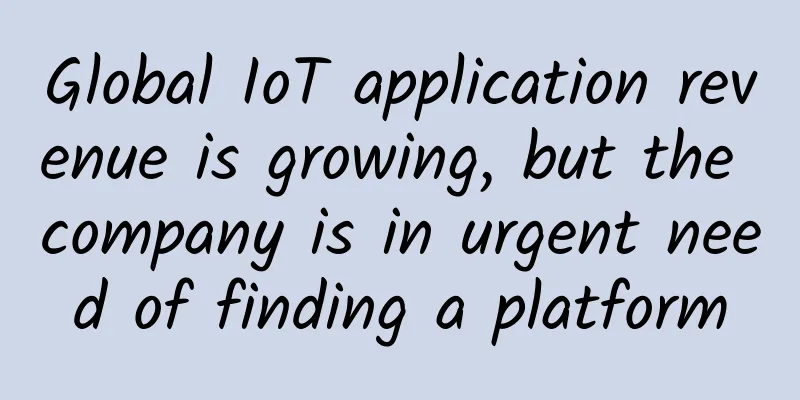Global IoT application revenue is growing, but the company is in urgent need of finding a platform

|
Enterprises and public sectors around the world are looking for ways to increase security, improve productivity, provide higher levels of service and reduce maintenance costs. The emergence of the Internet of Things has become a good choice to help companies improve key business processes and promote innovation in their product lines. According to MachNation's forecast, the revenue brought by global Internet of Things applications will reach US$1.8 billion in 2017 and US$64.6 billion by 2026, with a compound annual growth rate of 49%. The edge of the Internet of Things is gradually becoming the focus of the development of the Internet of Things. The so-called edge of the Internet of Things is a technical architecture that can provide computing and analysis capabilities near the point where data is generated. IoT edge computing enables certain processes to occur at the best location, creating a more secure, reliable and scalable IoT deployment. IoT deployments that use edge computing utilize connected IoT devices or gateways to provide functions in areas such as device integration, data collection, data processing, analysis and device management.
Because the edge is so critical to the success of IoT, leading IoT platform providers must deliver platforms that have a competitive advantage. This article discusses the capabilities that an edge computing platform must have. MachNation research shows that IoT edge platforms excel in five major capabilities. Vendors with a full set of capabilities to meet edge needs offer broad protocol support for data collection; robustness of offline capabilities; cloud-based orchestration capabilities to support device lifecycle management; hardware-independent scalable architecture; and comprehensive analysis and visualization tools. Broad protocol support for data acquisition Enterprise IoT systems require an edge platform that supports a broad ecosystem of devices and best-of-breed hardware vendors. Given that IoT is transforming many vertical industries and use cases, we expect that a wide variety of devices will be used to collect data and make it available to other IoT systems. Additionally, there are at least a few dozen widely accepted standards in enterprise applications, as well as a list of proprietary standards used in custom and existing products. Leading IoT platforms must support a wide variety of IoT devices with countless protocols for data extraction. Edge-focused platforms offer a comprehensive set of protocols that are ready to use right out of the box. The list of protocols for industrial-grade edge platforms typically includes staples like OPC-UA, BACNET, and MODBUS, as well as newer protocols like ZeroMQ, Zigbee, BLE, and Thread. In addition, the platform must be modular to support protocols, allowing customization of existing ones and development of new communication protocols. Vendors should also offer encryption, authentication, and data protection capabilities to address the highest enterprise security needs for connected mission-critical hardware. Products engineered to secure machine data are unique capabilities of leading IoT edge platforms. Offline robustness Enterprise IoT systems require a powerful edge platform that provides resilience, performance, and offline capabilities to reduce operating costs. To save resources or minimize the risk of connectivity interruptions, not all IoT assets need to be connected to the cloud. Nevertheless, most enterprise IoT deployments will rely on edge processing technologies. These technologies can handle the large amounts of data generated by connected assets, meet the low latency requirements of industrial systems, and meet established service level agreements (SLAs) for mission-critical assets. According to MachNation research, leading IoT edge platform vendors offer offline capabilities in three functional areas: data storage and normalization, event processing using rules and machine learning algorithms, and edge integration with local enterprise systems. First, edge systems need to provide two types of data normalization and storage. They must provide these services to successfully clean up noisy sensor data and support unreliable connections between the edge and the cloud, making the system more reliable and cost-effective. Second, the flexible event processing engine at the edge can generate insights from machine data. By analyzing this data using machine learning tools, companies can identify valuable behaviors for solutions such as predictive maintenance and cybersecurity. In addition, by applying a set of rules to this data, companies can automatically send fault alerts to detect faults in real time. Third, the IoT edge platform should integrate with local systems to optimize existing operational processes, including ERP, MES, inventory management, etc. Leading IoT edge platforms will provide edge integration with these types of existing operating systems to help ensure business continuity and access to real-time data. Cloud-based orchestration capabilities enable device lifecycle management Enterprise IoT systems require an edge platform with cloud-based orchestration capabilities to provide centralized management and oversight capabilities for supporting connected devices. An often overlooked but critical aspect of distributed IoT platforms is their ability to manage and orchestrate newly deployed technologies and processes associated with connected devices. To leverage the true value of IoT, IoT platforms must provide a set of centralized, efficient, and scalable tools to orchestrate the edge and cloud needs of connected assets. Cloud-based orchestration provided by IoT platforms addresses the configuration, monitoring, and update needs of connected assets. First, to simplify field deployment and increase security levels, platforms should provide factory configuration capabilities for IoT devices. These API-based interactions allow devices to be preloaded with certificates, keys, edge applications, and initial configurations before being shipped to customers. This significantly reduces the amount of field work and troubleshooting required to bring devices online. Second, once the devices are deployed and running, the platform should monitor the devices using machine and operational data streams that can be selectively synchronized with cloud instances. Third, using over-the-air update capabilities, IoT platforms should push updates securely to the edge. This includes updates to edge applications, the platform itself, the gateway operating system, device drivers, and updates to devices connected to the gateway. This enables nearly all aspects of the device lifecycle to be centrally managed and gives enterprises full control over IoT deployments that are distributed locally, nationwide, or globally. Hardware-independent, scalable architecture Enterprise IoT systems require an edge platform with a hardware-agnostic, scalable architecture to support a heterogeneous mix of devices deployed at scale. Most enterprise IT environments are made up of heterogeneous assets from different manufacturers, each with a unique set of capabilities, and IoT deployments are no exception. Actual IoT deployments use devices from multiple vendors, and over time, systems tend to accumulate components with each subsequent launch. IoT platforms that provide the latest features are able to run on a wide range of gateways and dedicated devices. IoT hardware uses chips based on ARM, x86 and MIPS architectures. Using containerization technology and local cross-compilation, these platforms provide a hardware-independent approach that allows the same functions to be deployed without changing the hardware. This greatly improves performance and reduces the technical and human costs of maintaining multiple versions of production software and hardware. In addition, forward-thinking platform providers use the same software stack at the edge and in the cloud, enabling seamless allocation of resources and ensuring that edge-based operations are not constrained by cloud-based tools. Platforms that can shift resources between the edge and the cloud are better suited to meet expected and unexpected application needs. This makes the entire system more scalable by improving elasticity and operational efficiency. Comprehensive analysis and visualization tools Enterprise IoT systems require an edge platform with comprehensive analytics and actionable visualization tools to provide insights to a diverse group of stakeholders. The most valuable element of an IoT system is the insights it brings to the enterprise, but extracting insights from rich machine data is very difficult. Due to resource, latency, and bandwidth constraints, the large amounts of data generated at the edge must be processed and analyzed at the point of generation. An IoT platform that fully supports analytics and visualization tools will enable enterprises to analyze data and provide actionable visualizations to end users. Leading IoT platforms will provide an open, modular approach to edge analytics, with out-of-the-box edge platforms that can aggregate data and run common statistical analyses. For functions that require specialized analysis, these platforms should be able to easily integrate leading analytical tool sets and use these tools to supplement or replace built-in functions. in conclusion Enterprises face many challenges when choosing to deploy IoT technologies. These challenges can affect the overall IoT deployment cost and time. Many enterprises are using IoT edge platforms to improve their key business processes while overcoming these deployment challenges. After enterprises choose an IoT platform with the above functions, they will be able to simplify the short-term deployment experience while providing long-term flexibility. Ten thousand enterprises choose to use new IoT services for innovation. |
<<: The secrets behind the IoT strategy of Internet giants at the end of 2017
>>: What are the most exciting IoT trends for 2018?
Recommend
IDC: Ethernet switch market grows 2%
According to IDC's Worldwide Quarterly Ethern...
Taking photos has never been so easy. Huawei Enjoy 10S freezes the wonderful scenery with one click
If we choose the most used function of mobile pho...
Solution to Failed to start LSB: Bring up/down networking when starting CentOS
I encountered this problem on a physical server. ...
Ruishu Information is listed as one of the cloud security example vendors in Gartner's "2021 China ICT Technology Maturity Curve Report"
In July 2021, Gartner, a global authoritative IT ...
API becomes the first choice for malicious attacks in 2022. How can enterprises protect API security?
With the vigorous development of cloud computing,...
OneWeb launches 182 more internet satellites into orbit
According to foreign media, OneWeb's 36 Inter...
How is the VoLTE development of the three major operators?
There are always various opportunities for indust...
[11.11] Megalayer: US/Hong Kong dedicated servers starting from 299 yuan/month, 1Gbps dedicated servers starting from 499 yuan/month
Megalayer has launched a promotion during the Dou...
Wang Xiaochu: Prepare for 5G and avoid making the same mistakes as in the 4G era
Recently, Wang Xiaochu, Chairman and Chief Execut...
Let's talk about TCP
In our daily development, we will more or less be...
The unlimited package has been cancelled? What does this mean for 5G?
It is reported that China Telecom announced that ...
Google withdraws from 2021 MWC World Mobile Communications Conference
The annual MWC World Mobile Communications Confer...
[Black Friday] RackNerd: VPS starts at $10.18/year, dedicated servers start at $59/month, multiple data centers in Los Angeles/San Jose/Utah, etc.
Just after Double Eleven, RackNerd released Black...
API Gateway: Layer 8 Network
An API is a set of rules that govern the exchange...
Who moved my Activity?
[[312428]] Preface I wonder if you have ever thou...









